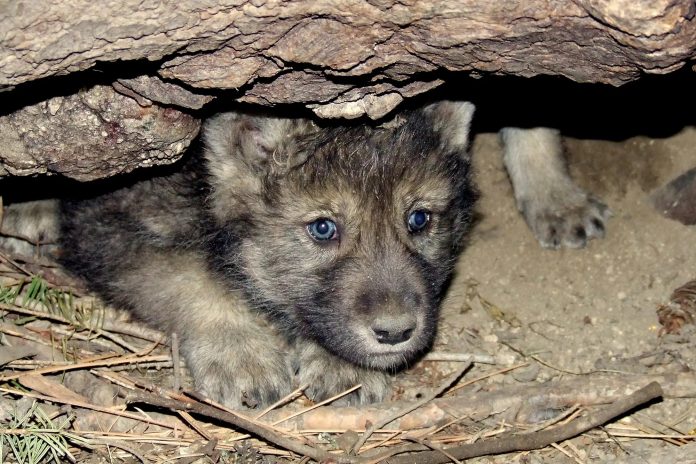Proposal For More Canadian Wolves Nixed; Wild Animals Moving Closer to Home
Trevor Phipps
As more wolves are linked to livestock deaths across the state, Colorado’s wolf reintroduction plan has reached another level of controversy.
Now, the feds are stepping in, a development that may ultimately kill the program, or heavily restrict what free-roaming wolf action could occur in our backyard. Teller County has not been impacted, but some area ranchers have feared it is only a matter of time before wild wolves start roaming across local lands.
According to multiple news sources, Colorado’s Division of Parks and Wildlife (CPW) signed a deal with British Columbia on Oct. 3 to reimburse them up to $400,000 for capturing 15 wolves to be relocated to Colorado this winter.
But then just a week later, the director of the U.S. Fish & Wildlife Service (USFWS) Brian Nesvik sent a cease-and-desist letter to Colorado Governor Jared Polis and CPW Director Jeff Davis. The letter claimed that Colorado was allowed to relocate wolves only with oversight by the USFWS.
The letter further explained that Colorado was only allowed to take wolves from areas in the “Northern Rocky Mountain Region” that consists of Idaho, Montana, Wyoming, the eastern third of Oregon, the eastern third of Washington, and north-central Utah. Therefore, relocating wolves from Canada violates USFWS policy.
“We have reason to believe that CPW may be seeking to capture, transport, and/or release one or more wolves from areas outside of the specified NRM (Northern Rocky Mountain) Areas outlined in the 10(j) rule,” Nesvik stated in his letter. “If CPW is currently engaging in such activities, CPW must immediately cease-and-desist any and all efforts related to the capture, transport and/or release of gray wolves not obtained from to (sic) the NRM Areas.”
The news could end up putting a damper on Colorado’s wolf relocation plan. Since the voter-approved wolf reintroduction plan started after the November 2020 election, Montana, Wyoming and Idaho have already told Colorado that the state could not relocate any of its wolves.
The first round of wolves was reintroduced in December 2023, and they came from Oregon. But in the years after the relocation, it has been determined that the Oregon wolves had a history of killing livestock. CPW originally promised not to relocate wolves that had a history of feeding on livestock.
For now, CPW officials have said that the agency is still looking at ways to reintroduce wolves while abiding by the USFWS’s rules. The legality of the letter has already been put into question, so the final outcome could end up being decided by the courts.
Banning New Wolves Altogether
After wolves have wreaked havoc across much of northern and western Colorado, one county has their eyes on coming up with their own localized solution. On Oct. 15, Montrose County Commissioners introduced an ordinance titled the “Non-Native Species Ordinance” that would essentially prohibit the “introduction, transport, release, support, facilitation, or habitat establishment” of any non-native species inside county limits. The ordinance specifically outlines Canadian gray wolves that have been brought to other parts of the state in the last two years.
“We respect wildlife, but we also have a duty to protect our way of life, our economy, and our property rights,” Montrose County Commissioner Sean Pond said in a press release. “This ordinance is about local control, responsible stewardship, and common sense.”
If the ordinance is passed, the introduction of a non-native species would become a petty offense punishable by a $1,000 fine per incident. If an animal was introduced in the county, there would be a separate violation for every day the animal was not removed from the county. Moreover, the state or any other entity “involved in wolf introduction shall bear all liability for any cattle depredation, property loss, or land devaluation arising from the presence of non-native species.”
To add more bullets in the battle against the reintroduction of wolves in Colorado, several congressional bills have been proposed that would delist the gray wolf as an endangered species and permit states more control in managing their wolf population. Some say this could lead to the open hunting and killing of predatory wolves who are preying on cattle and livestock. Critics, though, fear this could become a death call for the wolf species.
The most prominent of these efforts is the Pet and Livestock Protection Act, co-sponsored by Congresswoman Lauren Boebert, which has been gaining more support in recent weeks.
Wolves Moving Closer to Teller
So far Teller County has been left out of the wolf controversy, as only one lone female wolf entered the county since they were reintroduced and no incidents occurred. However, many believe that as more wolves get reintroduced between state boundaries, it is just a matter of time before they will make their way into Teller and possibly even El Paso counties.
Teller County could consider a similar ordinance to Montrose County, but Teller has thus far been out of the reintroduction range due to its close location to Front Range cities. So far, wolves have only been released in the central and western parts of the state in Grand, Summit, Eagle, and Pitkin counties.
According to CPW’s latest wolf tracking map that showed activity between Sept. 23 and Oct. 21, collared wolves in the state have covered quite a bit of ground. They have moved in closer to large metro areas like Fort Collins and Loveland. They have also been tracked along the Wyoming, Utah and New Mexico borders.
And whereas the wolves may have spread into previously untraveled territories in the north and south parts of the state, they have still mostly avoided Teller and surrounding counties for the time being. The closest any collared wolf got to the Ute Pass region last month was two counties over in Chaffee County in a watershed south and west of Salida.




